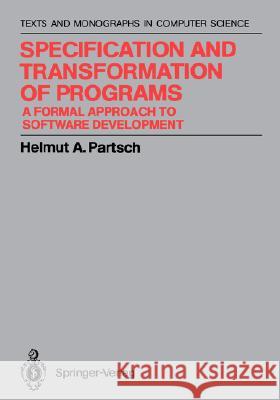Specification and Transformation of Programs: A Formal Approach to Software Development » książka



Specification and Transformation of Programs: A Formal Approach to Software Development
ISBN-13: 9783540525899 / Angielski / Miękka / 1990 / 493 str.
Specification and Transformation of Programs: A Formal Approach to Software Development
ISBN-13: 9783540525899 / Angielski / Miękka / 1990 / 493 str.
(netto: 191,21 VAT: 5%)
Najniższa cena z 30 dni: 192,74
ok. 22 dni roboczych
Dostawa w 2026 r.
Darmowa dostawa!
An introductory textbook on formal specification and transformational programming as an approach to software development.
1. Introduction.- 1.1 Software Engineering.- 1.2 The Problematics of Software Development.- 1.3 Formal Specification and Program Transformation.- 1.4 Our Particular View of Transformational Programming.- 1.5 Relation to Other Approaches to Programming Methodology.- 1.6 An Introductory Example.- 2. Requirements Engineering.- 2.1 Introduction.- 2.1.1 Basic Notions.- 2.1.2 Essential Criteria for Good Requirements Definitions.- 2.1.3 The Particular Role of Formality.- 2.2 Some Formalisms Used in Requirements Engineering.- 2.2.1 A Common Basis for Comparison.- 2.2.2 Flowcharts.- 2.2.3 Decision Tables.- 2.2.4 Formal Languages and Grammars.- 2.2.5 Finite State Mechanisms.- 2.2.6 Petri Nets.- 2.2.7 SA/SADT.- 2.2.8 PSL/PSA.- 2.2.9 RSL/REVS.- 2.2.10 EPOS.- 2.2.11 Gist.- 2.2.12 Summary.- 3. Formal Problem Specification.- 3.1 Specification and Formal Specification.- 3.2 The Process of Formalization.- 3.2.1 Problem Identification.- 3.2.2 Problem Description.- 3.2.3 Analysis of the Problem Description.- 3.3 Definition of Object Classes and Their Basic Operations.- 3.3.1 Algebraic Types.- 3.3.2 Further Examples of Basic Algebraic Types.- 3.3.3 Extensions of Basic Types.- 3.3.4 Formulation of Concepts as Algebraic Types.- 3.3.5 Modes.- 3.4 Additional Language Constructs for Formal Specifications.- 3.4.1 Applicative Language Constructs.- 3.4.2 Quantified Expressions.- 3.4.3 Choice and Description.- 3.4.4 Set Comprehension.- 3.4.5 Computation Structures.- 3.5 Structuring and Modularization.- 3.6 Examples.- 3.6.1 Recognizing Palindromes.- 3.6.2 A Simple Number Problem.- 3.6.3 A Simple Bank Account System.- 3.6.4 Hamming’s Problem.- 3.6.5 Longest Ascending Subsequence (“Longest Upsequence”).- 3.6.6 Recognition and Parsing of Context-Free Grammars.- 3.6.7 Reachability and Cycles in Graphs.- 3.6.8 A Coding Problem.- 3.6.9 Unification of Terms.- 3.6.10 The “Pack Problem”.- 3.6.11 The Bounded Buffer.- 3.6.12 Paraffins.- 3.7 Exercises.- 4. Basic Transformation Techniques.- 4.1 Semantic Foundations.- 4.2 Notational Conventions.- 4.2.1 Program Schemes.- 4.2.2 Transformation Rules.- 4.2.3 Program Developments.- 4.3 The Unfold/Fold System.- 4.4 Further Basic Transformation Rules.- 4.4.1 Axiomatic Rules of the Language Definition.- 4.4.2 Rules About Predicates.- 4.4.3 Basic Set Theoretic Rules.- 4.4.4 Rules from the Axioms of the Underlying Data Types.- 4.4.5 Derived Basic Transformation Rules.- 4.5 Sample Developments with Basic Rules.- 4.5.1 Simple Number Problem.- 4.5.2 Palindromes.- 4.5.3 The Simple Bank Account Problem Continued.- 4.5.4 Floating Point Representation of. the Dual Logarithm of the Factorial.- 4.6 Exercises.- 5. From Descriptive Specifications to Operational Ones.- 5.1 Transforming Specifications.- 5.2 Embedding.- 5.3 Development of Recursive Solutions from Problem Descriptions.- 5.3.1 A General Strategy.- 5.3.2 Compact Rules for Particular Specification Constructs.- 5.3.3 Compact Rules for Particular Data Types.- 5.3.4 Developing Partial Functions from their Domain Restriction.- 5.4 Elimination of Descriptive Constructs in Applicative Programs.- 5.4.1 Use of Sets.- 5.4.2 Classical Backtracking.- 5.4.3 Finite Look-Ahead.- 5.5 Examples.- 5.5.1 Sorting.- 5.5.2 Recognition of Context-Free Grammars.- 5.5.3 Coding Problem.- 5.5.4 Cycles in a Graph.- 5.5.5 Hamming’s Problem.- 5.5.6 Unification of Terms.- 5.5.7 The “Pack Problem”.- 5.6 Exercises.- 6. Modification of Applicative Programs.- 6.1 Merging of Computations.- 6.1.1 Function Composition.- 6.1.2 Function Combination.- 6.1.3 “Free Merging”.- 6.2 Inverting the Flow of Computation.- 6.3 Storing of Values Instead of Recomputation.- 6.3.1 Memo-ization.- 6.3.2 Tabulation.- 6.4 Computation in Advance.- 6.4.1 Relocation.- 6.4.2 Precomputation.- 6.4.3 Partial Evaluation.- 6.4.4 Differencing.- 6.5 Simplification of Recursion.- 6.5.1 From Linear Recursion to Tail Recursion.- 6.5.2 From Non-Linear Recursion to Tail Recursion.- 6.5.3 From Systems of Recursive Functions to Single Recursive Functions.- 6.6 Examples.- 6.6.1 Bottom-up Recognition of Context-Free Grammars.- 6.6.2 The Algorithm by Cocke, Kasami and Younger.- 6.6.3 Cycles in a Graph.- 6.6.4 Hamming’s Problem.- 6.7 Exercises.- 7. Transformation of Procedural Programs.- 7.1 From Tail Recursion to Iteration.- 7.1.1 while Loops.- 7.1.2 Jumps and Labels.- 7.1.3 Further Loop Constructs.- 7.2 Simplification of Imperative Programs.- 7.2.1 Sequentialization.- 7.2.2 Elimination of Superfluous Assignments and Variables.- 7.2.3 Rearrangement of Statements.- 7.2.4 Procedures.- 7.3 Examples.- 7.3.1 Hamming’s Problem.- 7.3.2 Cycles in a Graph.- 7.4 Exercises.- 8. Transformation of Data Structures.- 8.1 Implementation of Types in Terms of Other Types.- 8.1.1 Theoretical Foundations.- 8.1.2 Proving the Correctness of an Algebraic Implementation.- 8.2 Implementations of Types for Specific Environments.- 8.2.1 Implementations by Computation Structures.- 8.2.2 Implementations in Terms of Modes.- 8.2.3 Implementations in Terms of Pointers and Arrays.- 8.2.3 Procedural Implementations.- 8.3 Libraries of Implementations.- 8.3.1 “Ready-Made” Implementations.- 8.3.2 Complexity and Efficiency.- 8.4 Transformation of Type Systems.- 8.5 Joint Development.- 8.5.1 Changing the Arguments of Functions.- 8.5.2 “Attribution”.- 8.5.3 Compositions.- 8.5.4 Transition to Procedural Constructs for Particular Data Types.- 8.6 An Example: Cycles in a Graph.- 8.7 Exercises.- 9. Complete Examples.- 9.1 Warshall’s Algorithm.- 9.1.1 Formal Problem Specification.- 9.1.2 Derivation of an Operational Specification.- 9.1.3 Operational Improvements.- 9.1.4 Transition to an Imperative Program.- 9.2 The Majority Problem.- 9.2.1 Formal Specification.- 9.2.2 Development of an Algorithm for the Simple Problem.- 9.2.3 Development of an Algorithm for the Generalized Problem.- 9.3 Fast Pattern Matching According to Boyer and Moore.- 9.3.1 Formal Specification.- 9.3.2 Development of the Function occurs.- 9.3.3 Deriving an Operational Version of ?.- 9.3.4 Final Version of the Function occurs.- 9.3.5 Remarks on Further Development.- 9.3.6 Concluding Remarks.- 9.4 A Text Editor.- 9.4.1 Formal Specification.- 9.4.2 Transformational Development.- 9.4.3 Concluding Remarks.- References.
1997-2025 DolnySlask.com Agencja Internetowa
KrainaKsiazek.PL - Księgarnia Internetowa









